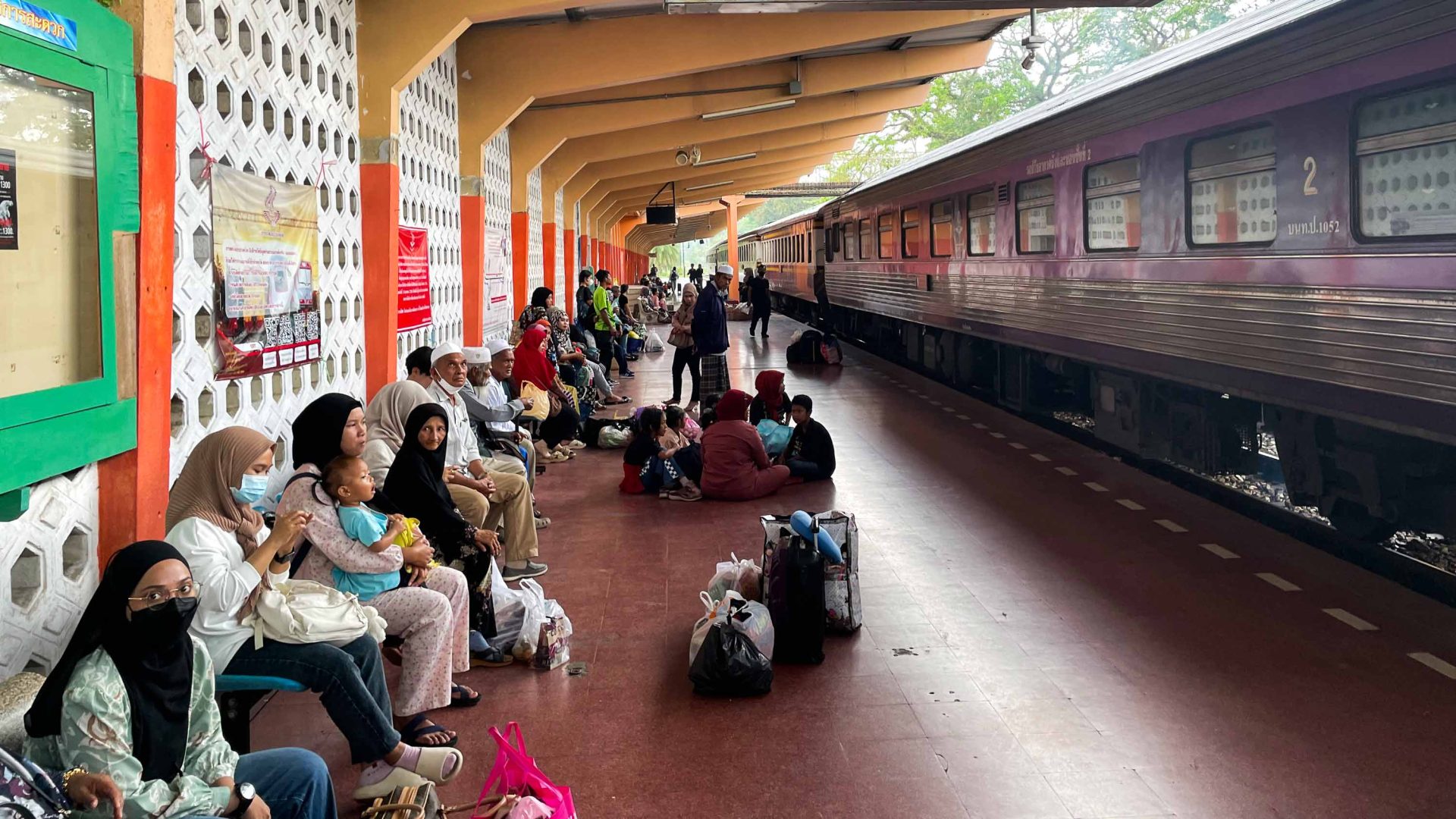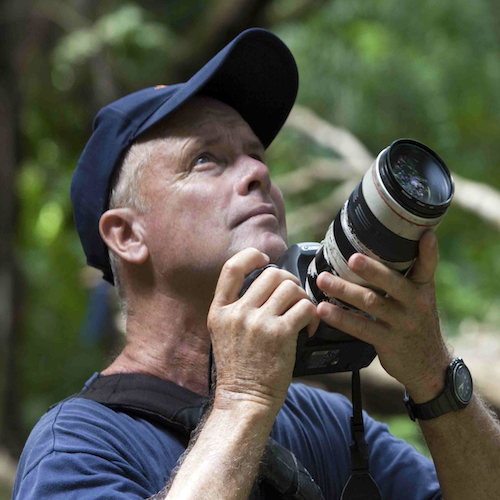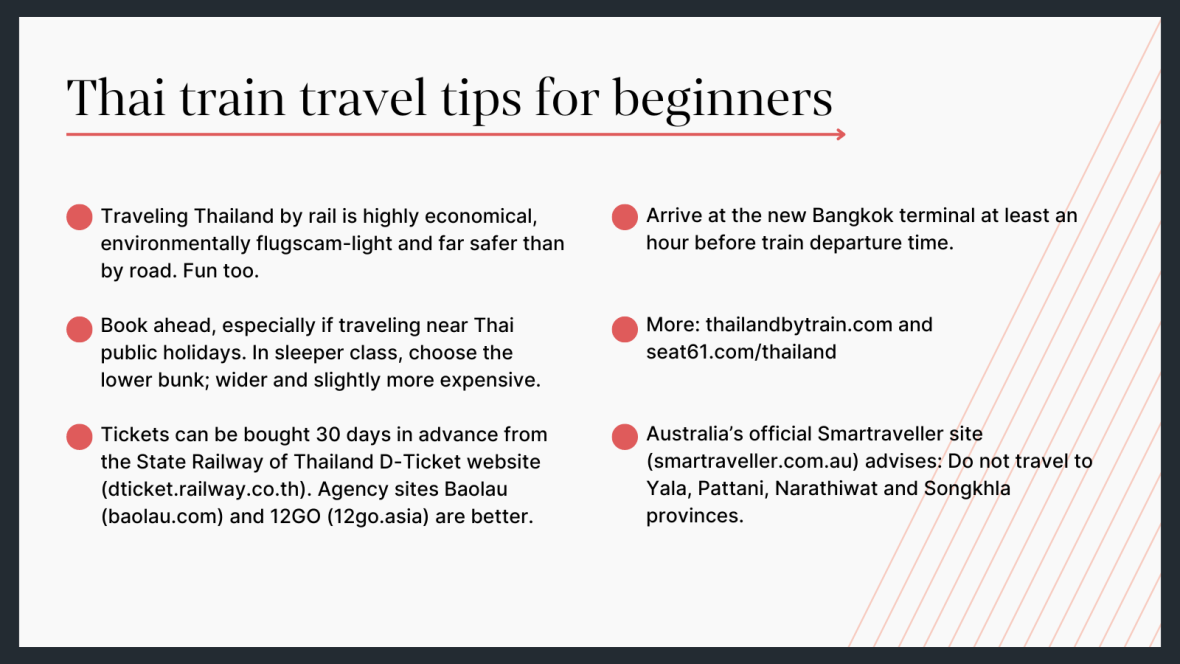
Spurred on by an urge to ride the rails, and keep riding the rails, and then ride some more rails, writer John Borthwick heads off on the longest border-to-border Thailand rail route he can find.


Spurred on by an urge to ride the rails, and keep riding the rails, and then ride some more rails, writer John Borthwick heads off on the longest border-to-border Thailand rail route he can find.
A red-hot sun bellyflops, slowly, into the Mekong. For a moment, I imagine the great mother river erupting, boiling itself dry like a thermo-nuclear tea kettle.
The river is as calm as a monk. And as the sun recedes, a thumbnail moon soon hangs in the dusk above it. Propped on the Thai shore with the lights of Laos coming on across the water, I ask myself, “Why leave?”
Arriving somewhere special, only to then leave it for somewhere else is the paradox that inhabits most of our travels. I’ve come to Nong Khai in northeast Thailand in order to leave—in this case on a train, and then on more trains, from Laos to Malaysia via the longest border-to-border Thailand rail route I can find.

Every Thai train station has a gleaming brass bell. At 7.45am sharp, Nong Khai’s station master steps up to his one and gives it a resounding whack. Train 76 lurches forward, moving south to Krung Thep, aka Bangkok.
My dreams, if any, are punctuated by level crossing bells, rattling bridges and midnight halts at Chumphon and Surat Thani. But, come dawn, I’m looking out on a new yet old world, a lush southern landscape of jungle, palms and rubber plantations, mosques not wats, and females of all ages in hijab.
Arctic aircon, the way Thais like it, chills this second-class carriage. But the seats are padded, unlike the slatted benches of hard-arse class that I recall from years ago. A snappily-dressed conductor scans our tickets. My fellow travelers are mothers and kids, couples, and a rotating cast of snack vendors who work the aisles. Shun, a Japanese traveler in the seat next to me, soon pulls down his hoodie and barely stirs for the rest of the journey.
The day warms up and so does our carriage. I’m shedding layers. The air-conditioner is on the blink, so I wander back to third class where luxury is windows that open. Armies of engineers invade our car to reboot the AC and soon enough we rumble on again, re-chilling. Lunch sellers hop aboard. I score a chicken rice dish but the only chook-like element is a fried egg on top.
Khon Kaen, Bua Yai and “Nakhon Nowhere” hamlets fly by. Palm trees, cane fields and wind farms. After six hours, the first hill, and then the first tunnel. An elevated highway looms with its overpass arms outstretched—the exoskeleton of the approaching capital. With 620 kilometers (385 miles) behind us, right on time at 4.45pm we roll into Bangkok’s new Krung Thep Aphiwat Central Terminal. Shun shakes himself awake, shoulders his pack and exits.
I pause the long haul south for a night out with friends, and next day, am ready to leave again. Previously this would have been from Hualamphong station, the century-old, thumping heart of Thailand’s 4,846-kilometer (3,000-mile), meter-gauge rail system. A throwback to the glory days of steam, ornate Hualamphong gave any journey a ceremonial kickstart as you stepped aboard for who-knows-what adventures.
Instead, I retrace my steps to Sathani Klang Krung Thep Aphiwat—the official Thai name of Bangkok’s vast new USD$3 billion rail hub. It looks like an airport, minus the winged things. Airport-style too, we passengers have to wait for a boarding call before being channeled to the platform where our ride, the new Chinese-built Special Express 31 stands ready.
I’ve treated myself to a first-class berth, but end up as the only occupant in the comfortable twin-share sleeper cabin. We’re off, from Bangkok to Hat Yai. The suburbia soon turns to rice fields, the traffic jams to villages, and afternoon to dusk. This securely zip-locked, 21st-century train doesn’t allow roaming vendors on board so I order a restaurant tray meal, another chicken flop. Mai pen rai—nevermind.
Having seen the dining car and the curtained sleeping catacombs of second class, there’s little to do but head for bed. My dreams, if any, are punctuated by level crossing bells, rattling bridges and midnight halts at Chumphon and Surat Thani. But come dawn, I’m looking out on a new yet old world—a lush southern landscape of jungle, palms and rubber plantations, mosques not wats, and females of all ages in hijab.

Sixteen hours and 940 kilometers (585 miles) from Bangkok, Special Express 31—iron horse or trojan horse?—glides to a halt at Hat Yai Junction. I weave through the platform hullaballoo to the unique door of the Train Hotel, “the only hotel in Thailand in a train station.”
Gold shops, massage, malls and the latest Thai thing: Cannabis boutiques. Although the Thai-Malaysia border is still far distant, Hat Yai already has that frontier feeling—transience, guilty pleasures, bargain shopping. Mostly, I like its half-speed pace, when compared to the north. So I hang around for a spell of tasty nasi lemaks and mash-up patois talk in Thai-English-Malay.
Mid-afternoon. Sungai Kolok is a drab, gray town. Peaceful to boring. I walk around, seeing no honky-tonk bars, avid youths or armored cars guarding the discos (as they once did). No bomber jackets or G-strings. Just a town along the way. Either I’m too late in the century or it’s too early in the day.
The last 250 kilometers (155 miles) of the journey, aboard an old-style train from Hat Yai to Sungai Kolok, takes me through Thailand’s ultimate south, the secessionist-troubled provinces of Songkhla, Yala, Pattani and Narathiwat. Centuries of arm-wrestling—Kingdom versus Sultanate—still echo here, periodically erupting into separatist bombings and ambushes. But looking out the train today it’s all peaceful-as; almost timeless as—the question hangs—Siamese Malaya or Malayan Siam?
That it is definitely Thailand today is made clear when an Army patrol enters our carriage, AK-47s and all. A soldier takes a few overall photos; another checks the locals’ IDs. Nothing aggressive, all polite, Thai-style. As a middle-aged Westerner, I’m not looking too fanatic this morning but, being the only one of my tribe, the leader stops to talk a while before the patrol moves on.
My friend, writer John Maddocks recalled traveling this line 50 years ago: “Separatist insurgents were blowing up the tracks and there was a definite element of risk. I was on an overnight journey and planned to sleep on the carriage floor. But the ticket collector thoughtfully pointed out that if the track was blown up I’d be closest to the blast.”
Author Paul Theroux rode these rails and wooden seats while on his epic 1973 journey that resulted in The Great Railway Bazaar. He noted a “doddery white man in a torn shirt with laces undone, his fly half unzipped.” He wondered if, “in a matter of years, that wandering old coot, the ghost whom no one noticed, would be me?” I check my own shirt (intact), shoelaces (still tied) and so on, reassured that I don’t yet resemble Theroux’s disheveled old wraith too long on the road.
The train line terminates at Sungai Kolok, which borrows its name from the 50-meter wide squiggle of river that separates Thailand from Malaysia. Beyond the official border post are “informal” river crossings where consumer goods slip north while Thai rice, cashews, cannabis and more head south. People, as they will, shuttle in both directions.
“Tijuana meets Kabul” was the surreal description of Sungai in the early-2000s, when tooled-up jihadists took violent exception to the town’s bawdy nightlife. Sitting cheek-to-jowl with Kelantan, Malaysia’s most fundamentalist state, Sungai Kolok inevitably possessed a booming brothel economy. As crime novelist John Burdett observed there, “great hordes of pious young Muslim men from Malaysia cross the border here and leave their piety on the other side.”
Mid-afternoon. Sungai Kolok is a drab, gray town. Peaceful to boring. I walk around, seeing no honky-tonk bars, avid youths or armored cars guarding the discos (as they once did). No bomber jackets or G-strings. Just a town along the way. Either I’m too late in history or it’s too early in the day.
And that’s just fine. I’ve done my slow horse dash and with a wink to old Basho, followed the narrow gauge to the deep south. Station to station, nation to nation, bookended by borders of water. Time to move on.
***
Adventure.com strives to be a low-emissions publication, and we are working to reduce our carbon emissions where possible. Emissions generated by the movements of our staff and contributors are carbon offset through our parent company, Intrepid. You can visit our sustainability page and read our Contributor Impact Guidelines for more information. While we take our commitment to people and planet seriously, we acknowledge that we still have plenty of work to do, and we welcome all feedback and suggestions from our readers. You can contact us anytime at hello@adventure.com. Please allow up to one week for a response.

One of Australia’s leading travel writers, John Borthwick's work appears in The Weekend Australian, Fairfax Traveller and many others—all of which keeps him too long away from surfing good waves or hiking some gob-smacking coastline.




Can't find what you're looking for? Try using these tags: